Bob- Cripple River, AK. '11.
Nothing like having an adventure of a lifetime. For me it was getting to go
to the GPAA Alaska Expedition up at Cripple River, near Nome, AK.
Here are some of my impressions.
Here are some of my impressions.

Cripple River Camp looking northwest on a stunning late evening about 9:00pm.
The Traveling
In another life I had the opportunity to travel a lot via airlines, and grew to dislike the mode of travel due mostly to the boredom of sitting for so long. So much so that if a flight was within 5 hours of driving times, I would pass on the flight and drive instead. At least while driving you did a bit more than just sit. Well this trip was a bit further... Orlando, FL to Nome, AK... something like 4500 miles, (or so), and there isn't any roads that will get you there. :)
Leave 6:30pm, arrive 9:30am the next day... With 4 hours difference for the time zones, makes it about 19 hours of traveling one way.
Any way you look at it, the trip there and back was a long one. One that was worth it, and surprisingly passed by pretty quickly.
Must of been the excitement of it all.

Mt. Rainer as seen when arriving in Seattle.

Anchorage Terminal.

Waiting for the flight to Nome.

Been a while since I've boarded a jet without a Jetway.

The terminal in Nome.

Fellow chapter member Ed.
We made it to Nome...

The Alaskan Highway... Just another drive on the beach.
Although not quite as smooth as Daytona. :)
The time in the air passed quickly, as did the layovers. Even the one in Anchorage at just over 3 hours passed by pretty fast. One quick stop in Kotzebue, lets me say that I made it above the Arctic Circle. The pilot announced it was sunny and clear, 65 degrees here in Kotzebue, and for brief moment I thought maybe the weather reports I read about Nome were incorrect.
Well, Landing in Nome on time about an hour later proved them correct. Windy, 50 degrees, and a light rain falling greeted us outside the terminal. This was a nice day, at least when I compare it to some of the others Nome had in store for me over the next two weeks.

Some of the accommodations of the local prospectors,
as seen on the way to the Cripple River Camp.
The Cripple River Camp
A short 13 miles of driving later, about 35-45 minute drive on the Alaskan Highway you reach the Cripple River Camp.

Chow hall (l), Administration (r).

Camp store (l), Medical Clinic (r).

Hooches for the volunteer staff.

With tons of ATV parking available.

My hooch was "D", down this row.

Cleaning some concentrates later the second week.
That's my bunk behind me.
This was it for the next two weeks. Breakfast at 7am, lunch at Noon, and dinner
at 6pm. The generator was turned off at 10pm, back on at 6am. Outside
of that structure anything else was possible, and if you missed one of meal times,
you had plenty of choices of other items to make up for it.
My Frist week was wet, windy, and cold, so much so that the day we landed was one of the better ones out of the next five.
Beach Mining
The first day here I spend time unpacking, and checking out the camp. With pan in hand, I headed up and down the beach here on the Bering Sea and sampled several patched of exposed red sands. Not one of them came up empty. There's Gold in them there sands! Tiny pieces of gold in every pan. Maybe 5 at least up to 30 at the most in one spot near the mouth of the cripple River.
The Second day everyone had to take a class on using the Beach box. It's set up, placement of the Pumps, and hoses, and most importantly, placing the water intake foot valve in the Bering Sea. This was easy to do, but when the seas came up, there no keeping it in place, so the beaches get closed. This was the case on days 3, 4,and 5 as the weather changed for the worse.
My Frist week was wet, windy, and cold, so much so that the day we landed was one of the better ones out of the next five.
Beach Mining
The first day here I spend time unpacking, and checking out the camp. With pan in hand, I headed up and down the beach here on the Bering Sea and sampled several patched of exposed red sands. Not one of them came up empty. There's Gold in them there sands! Tiny pieces of gold in every pan. Maybe 5 at least up to 30 at the most in one spot near the mouth of the cripple River.
The Second day everyone had to take a class on using the Beach box. It's set up, placement of the Pumps, and hoses, and most importantly, placing the water intake foot valve in the Bering Sea. This was easy to do, but when the seas came up, there no keeping it in place, so the beaches get closed. This was the case on days 3, 4,and 5 as the weather changed for the worse.
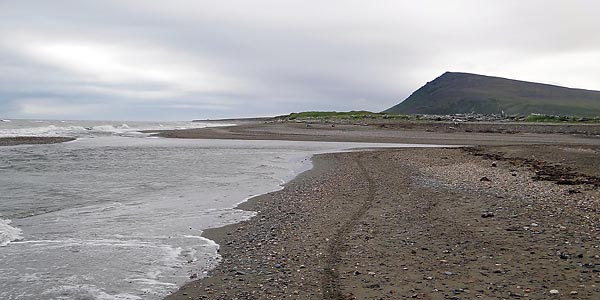
The mouth of the Cripple River.

The Tundra meets the Bering sea.
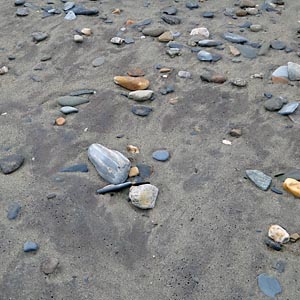
Red sands on top... it's got gold...

Taking a class on using the new Keene Beach box.
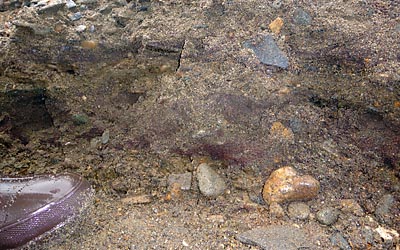
Layers near the bottom of Claim #10b.
Nice and dark red with some solid black.
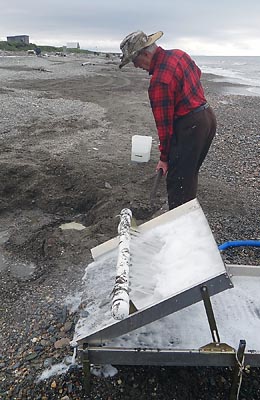
My partner Max working the box.
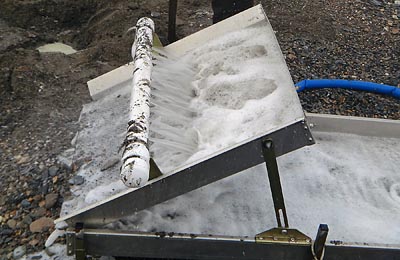
The Keene Beach Box in action.

Nothing like Gold showing as the last thing to leave the black tub after a cleanup.
The GPAA assigns a pair of prospectors to a beach claim. Each claim is about
40 feet wide running from the water to the tundra. My initial claim was #21,
pretty far down the beach almost in front of Tom and Cindy's House. On the
first day, a staff member saw me checking it out, and afterwards switched me to
#10b. A lot less walking, and #10a was with fellow hoochmates. This made
it a lot easier, as we all helped each other out.
My Partner was fellow Hoochmate Max. A WWII veteran, pilot, and prospector for 30+ years. I never asked him his age, but it must be near 85 or older. I could write a lot here about him if I choose, but I'll leave it with 2 statements.
"What day is it? Sunday?" (inside joke), and,
I hope if I reach his age I still have it as good as he does.
My Partner was fellow Hoochmate Max. A WWII veteran, pilot, and prospector for 30+ years. I never asked him his age, but it must be near 85 or older. I could write a lot here about him if I choose, but I'll leave it with 2 statements.
"What day is it? Sunday?" (inside joke), and,
I hope if I reach his age I still have it as good as he does.
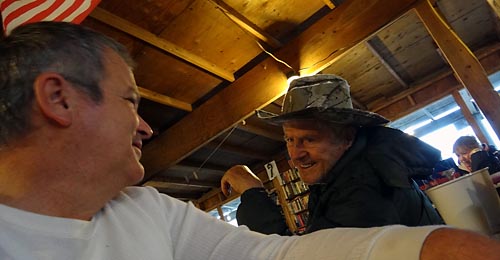
Me and Max.
On days the beach was closed, If you were able, you could cart sands over to one
of the Older style Beach Boxes which were set up on the Cripple River.
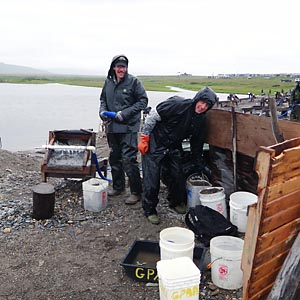
Fellow Native Alaskan Hoochmates Jeff and Don working an older beach box on the Cripple River.
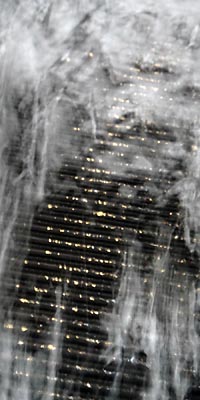
Yes, the Older Box catches the gold also.
I mined the Beach everyday it was open, with some days putting in as much as 10
hours. Max joined me on the days of his choosing, and on the others I worked
alone. Once you had a trench dug up on the beach that was 3 feet wide, the
rest came a bit easier, as you could remove just the better layers, undermining
the main body of sand, until it collapsed. Most of the sand that falls ends
up in the vacant area you already processed, so in effect you only move maybe 40%
of the overburden. It's a lot of work in any regard, and after those long
days my body was letting me know, and by 10pm you wanted nothing but sleep.
Surprisingly in the morning each day all the aches and pains were gone. Knee joints that were burning some, shoulders that ached, all felt good. Just give it about a couple of hours after starting to work again... :)
Surprisingly in the morning each day all the aches and pains were gone. Knee joints that were burning some, shoulders that ached, all felt good. Just give it about a couple of hours after starting to work again... :)
Highbanking near the Trommel Operation.
I was able to get to the highbanker operation on two occasions. The first time was definatly the better adventure. Tuesday of the first week, the beach was closed for the second day in a row, and it was good to get out for some mining. The trip to the Highbankers at the trommel area via trucks takes you through Nome, as it's about 30 miles one way. In Nome we got about 30 minutes to get anything we wanted to in one of the local stores. Needless to say it was a bit of a shock to see some of the prices, but then everything in Nome is barged or flown in, so costs are high.
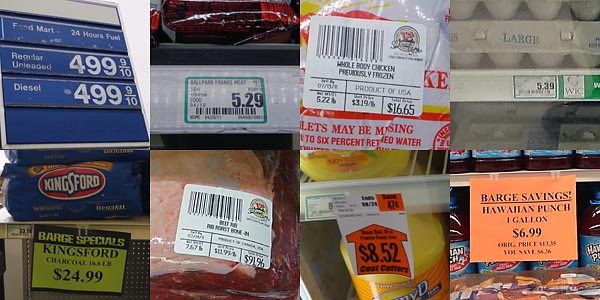
Some of the prices in Nome.
Anyway, back to the highbanker... I road in the back of the truck on the way
out, knowing that after the day was over I'd have a seat inside for the trip back.
And I'm glad I did, as this day ended up being the worst day weather wise
for the two weeks. At the highbanker area there's small foothills that offer
some protection from the winds, so it seemed to us to be as bad as any other time
so far. Back on the beach the winds were picking up, and pushing up the height
of the Bering Sea on the beach. It seems wind effects this more than tides
do, as the tide is about 1.5 feet. Anyway the day ended at the highbankers,
we cleaned up, and no one was yelling about getting a nice picker, so we packed
into the trucks and headed back.
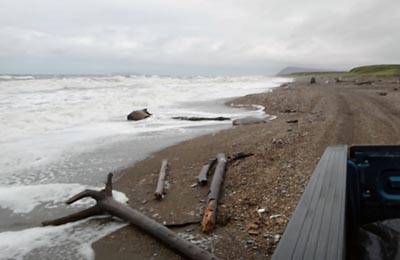
Heading out, a lot of new firewood showed up over night.
and sadly a dead whale... (food for grizzlies.)
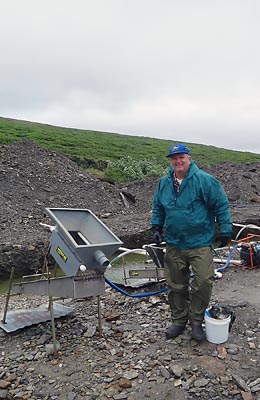
Ready to start working.
The trip back was like no other. The CB radio was a buzz. Chatter about
trucks stuck in the sand, Make sure to ride up top, Stay off the wet sand, etc.
Needless to say a 45 minute trip now was taking 2+ hours as we slowly meandered
between all the tree trunks, driftwood, and debris up on the top of the beach. The
Alaskan Highway as i knew it before was gone, under the wave action of the Bering
Sea which is up a few feet, and displaying some waves near 10 feet.
The crews were a bit hesitant about crossing the Penny River. This usually was maybe 1-2 feet deep at the spot they cross. Now with new the storm blown water height, it looked as if the trucks wouldn't be able to make it across. Even with the added height from the oversized tires, and jacked up suspension, crossing the Penny saw water coming into the cab. Looking out the windows seemed as if we were sitting in a rowboat. But the crew took it real slow, and with a bit of slipping and sliding we made it across.
Here is a couple of links to video from the trip back...
This first one is an attempt to show how rough the ride back was, by attempting to hold the camera on the dashboard. It worked for the most part for the side to side, but I couldn't hold it in place for the big ups and downs... 3.8mb load size...
This Second one is of us later in the same trip crossing the Penny River which was up about 2 feet higher than normal. It's a bit longer so may take a bit to DL into the viewer.
The crews were a bit hesitant about crossing the Penny River. This usually was maybe 1-2 feet deep at the spot they cross. Now with new the storm blown water height, it looked as if the trucks wouldn't be able to make it across. Even with the added height from the oversized tires, and jacked up suspension, crossing the Penny saw water coming into the cab. Looking out the windows seemed as if we were sitting in a rowboat. But the crew took it real slow, and with a bit of slipping and sliding we made it across.
Here is a couple of links to video from the trip back...
This first one is an attempt to show how rough the ride back was, by attempting to hold the camera on the dashboard. It worked for the most part for the side to side, but I couldn't hold it in place for the big ups and downs... 3.8mb load size...
This Second one is of us later in the same trip crossing the Penny River which was up about 2 feet higher than normal. It's a bit longer so may take a bit to DL into the viewer.
The Wildlife.
On the ride out to the camp on the very first day, we passed by a fully grown dead buluga whale. Those are the white ones for those that cannot remember. We were informed that it is now the local fare for many of the predators of the area, namely the Grizzlies. These were the first to be seen, later the first day, as a mother and her 2 year old cub circled north of the camp on their way over to the whale. By Tuesday, on the trip out to the highbankers there was another dead whale. A smaller different species, of which I'm still not sure of. It was a bit upsetting to see them, but this is natures way. As what washes up provides food for others. Sorry to say, no photos of the bears.
Large Gulls, and Arctic Terns were always around the camp, looking for handouts as the fishermen would leave the remains of the salmon carcas they caught on the sand for them. A young seal was spotted several times, but the biggest event has to be with the Musk Ox.
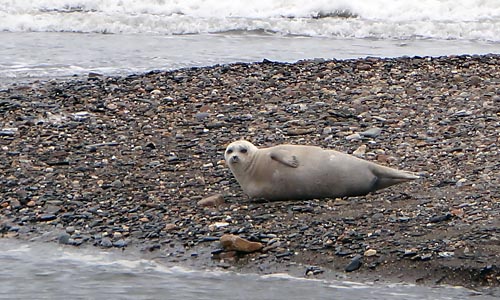
A young seal.
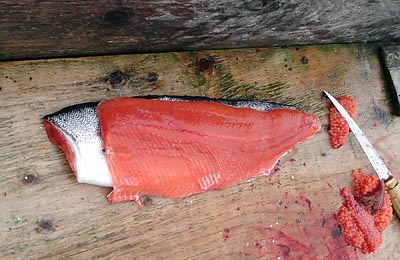
Fresh Pink Salmon...
Towards the end of the First week at the Camp before everyone was up a herd of Musk
Ox crossed the Cripple River, and walked through camp out to the camp side of the
mouth of the Cripple River. This turned out to be a site seeing event for
the camp as everyone with a camera was heading over for a few shots. They
stayed on the point till after some time lunch or dinner, I forget, but when the
left, they just walked back through onto the tundra near camp, along the Cripple
River, finally crossing it and running up over the far hillside.

Musk Ox surrounding one of its young at the mouth of the Cripple River.
Here's a short vid of the Musk Ox as they walked along the Cripple River near camp.
Tips, if you plan to make the trip.
* For me sleeping was not much of an issue except for the getting up for natures calling at 2-3am. One thing the GPAA doesn't tell you is that the wood burning stoves only operate for maybe 4 hours on a full load. This made for some rather chilly events. That first week it rained so much there pretty much wasn't any dry wood to be had. In our hooch as others, wood was stacked close to the stove in hopes it would dry some. For the most part it worked, but there was a few times it burned really, really slow, and cool, not enough heat if you asked me. There's nothing like getting up to a 45 degree Hooch, with no hope in getting a fire started for at least 30 or so minutes.
* Have all your mates check the Wood Stove through the night as each of you get up. If there is room for a log or two, then put them in.
* As for a Sleeping Pad. The first week, I used just a 6 inch air mattress, with my sleeping bag as a comforter, sleeping with a layer of clothing usually, as the bottom of my body was always cold. It seems that you will still loose a lot of heat to the radiant cooling effect right through the air mattress, plywood deck, and the 2 food gap to the Hooch floor. The Tundra under the hooch is still Frozen, and that cold has its effect. The GPAA Store has some spare sleeping pads, as it seems many prospectors will leave theirs behind each year in favor of taking more concentrates back home. The second week I also used a 2 inch pad that contained some foam. Even though this couldn't be inflated anymore, that little bit of foam stopped the heat loss.
* When working the beach, do so even on the days it's closed, as you can stockpile the better material for the days when its open.
* If you can afford it, get an ATV as you will be limited to the beach, and the GPAA sponcored events. It's a necessity if you plan to head to any of the remote camps. Better yet, pay the extra for the 4 wheel drive ones, as once the trails are too sloppy due to the weather, they will be closed to the 2 wheel drive ATV's.
* Plan on getting a bit sick. I was lucky enough just to have a sore throat for a day, and a slight cough for another one, but others had it pretty bad. No worries, as the GPAA has a Doctor and nurse on site for no cost medical treatment. At least no cost as long as you don't require leaving the camp for treatments.
* Try to keep your morning constitutional in the morning, and time it for when the crew just finishes their round of cleaning. :) There's nothing like Outhouses...
* During the draw, pick the first chip you touch... Don't go digging for one... It worked for me the second week...
